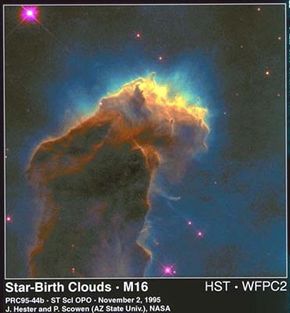The Life of a Star
As we mentioned before, stars are large balls of gases. New stars form from large, cold (10 degrees Kelvin) clouds of dust and gas (mostly hydrogen) that lie between existing stars in a galaxy.
- Usually, some type of gravity disturbance happens to the cloud such as the passage of a nearby star or the shock wave from an exploding supernova.
- The disturbance causes clumps to form inside the cloud.
- The clumps collapse inward drawing gas inward by gravity.
- The collapsing clump compresses and heats up.
- The collapsing clump begins to rotate and flatten out into a disc.
- The disc continues to rotate faster, draw more gas and dust inward, and heat up.
- After about a million years or so, a small, hot (1500 degrees Kelvin), dense core forms in the disc's center called a protostar.
- As gas and dust continue to fall inward in the disc, they give up energy to the protostar, which heats up more
- When the temperature of the protostar reaches about 7 million degrees Kelvin, hydrogen begins to fuse to make helium and release energy.
- Material continues to fall into the young star for millions of years because the collapse due to gravity is greater than the outward pressure exerted by nuclear fusion. Therefore, the protostar's internal temperature increases.
- If sufficient mass (0.1 solar mass or greater) collapses into the protostar and the temperature gets hot enough for sustained fusion, then the protostar has a massive release of gas in the form of a jet called a bipolar flow. If the mass is not sufficient, the star will not form, but instead, become a brown dwarf.
- The bipolar flow clears away gas and dust from the young star. Some of this gas and dust may later collect to form planets.
The young star is now stable in that the outward pressure from hydrogen fusion balances the inward pull of gravity. The star enters the main sequence; where it lies on the main sequence depends upon its mass.
Advertisement
Now that the star is stable, it has the same parts as our sun:
- core - where the nuclear fusion reactions occur
- radiative zone - where photons carry energy away from the core
- convective zone - where convection currents carry energy toward the surface
However, the interior may vary with respect to the location of the layers. Stars like the Sun and those less massive than the sun have the layers in the order described above. Stars that are several times more massive than the sun have convective layers deep in their cores and radiative outer layers. In contrast, stars that are intermediate between the sun and the most massive stars may only have a radiative layer.
Life on the Main Sequence
Stars on the main sequence burn by fusing hydrogen into helium. Large stars tend to have higher core temperatures than smaller stars. Therefore, large stars burn the hydrogen fuel in the core quickly, whereas, small stars burn it more slowly. The length of time that they spend on the main sequence depends upon how quickly the hydrogen gets used up. Therefore, massive stars have shorter lifetimes (the sun will burn for approximately 10 billion years). What happens once the hydrogen in the core is gone depends upon the mass of the star.
